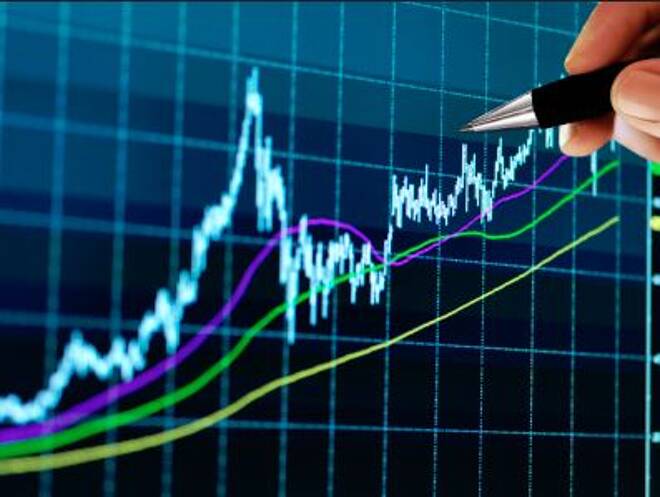Advertisement
Advertisement
EUR/USD Daily Technical Analysis for May 23, 2017
By:
The EUR/USD continued to move higher as divergent oppinions amongst ECB members could lead to a change to a tightening bias as opposed to a neutral bias.
The EUR/USD continued to move higher as divergent oppinions amongst ECB members could lead to a change to a tightening bias as opposed to a neutral bias. Yields in Europe have increased at a more rapid pace relative to their U.S. counterparts, which have been having trouble climbing following softer than expected economic data. The German 10-year yield is a mere 37 basis points, and it has a long way to climb to catch up to the U.S. which is closer to 2.25%.
Technicals
The EUR/USD moved higher continuing the uptrend, hitting 1.1263, in route to resistance near the November highs at 1.1299. A break of this level would lead to a test of the August 2016 highs at 1.1365. Support on the currency pair is seen near the 10-day moving average at 1.1033.
Momentum as reflected by the MACD (moving average convergence divergence) index is positive. The index is printing in the black, and the trajectory of the MACD histogram is moving higher which reflects accelerating positive momentum of the EUR/USD.
The RSI (relative strength index) which is a momentum oscillator that measures accelerating and decelerating momentum, as well as overbought and oversold levels, is moving higher and breaking out which reflects accelerating positive momentum. The only issue is the elevated level of the RSI which is above the overbought trigger level of 70. The last time this occurred, in May of 2016, the exchange rate preceded to tumble 12 big figures.
The EU Calls on German to Accelerate Public Investment
EU Commission calls on Germany to accelerate public investment and create conditions for wage growth to pick up. At the same time the country should use fiscal policy to support demand. Given that the German economy is already close or above capacity and that monetary policy remains very expansionary an equally expansionary fiscal policy is a controversial recommendation, but it reflects the prevailing sense that budget surpluses should be used for spending and investment rather than debt reduction, even though debt levels across the whole of the Eurozone remain high. German wage growth meanwhile remains above the Eurozone average, but admittedly looks rather low considering that the labor market is very tight.
There are diverging opinions on the ECB’s Governing Council but theExecutive Board has been united in its defense of the central bank’s still very accommodative policy and the insurance policy that the implicit easing bias still provides. However, with confidence indicators showing a more robust economy, labor markets improving, and political risks receding, it seems the discussion about how quick the pace of moving toward normalization should move. The ECB’s path to exit steps has reached the Executive Board. Praet is urging caution to avoid a taper tantrum, while dove Coeure warns against excessive gradualism. Not that tapering will be an issue for June, but it seems Praet wants to merely remove the easing bias and turn to a neutral stance, while others want the ECB to signal a tightening bias.
ECB Speak Should Confirm Opinions
Praet and Coeure as well as ECB President Draghi are all scheduled to speak during the week and it will be interesting to see their views. What is clear is that the discussion is ongoing and political events and market volatility will likely be equally important.
The ECB Weidmann is on the hawkish side of the equation and says that the central bank needs to act if price pressures rise. The Bundesbank President told Austria’s Die Presse that the central bank mustn’t postpone monetary policy normalization for fear of hitting national budgets or losses for investors. Weidmann stressed that the central bank’s policy doesn’t hinge on political events, but price pressures. He said that at the current moment nobody doubts that an expansionary policy is appropriate, but added that there are different opinions on the necessary degree of expansion and the instruments used.
The U.S. Chicago Fed National Activity index rose in April
U.S. Chicago Fed National Activity index rose to 0.49 in April, better than expected, after dipping to 0.7 in March (revised from 0.8) from 0.15 in February (revised from 0.27). The 3-month moving average improved to 0.23 in April from March’s unchanged level (revised from 0.03), while February was nudged to 0.15 from the prior 0.16 reading. Helping boost the headline index were gains in production-related indicators. The index is a weighted average of 85 indicators where a positive print corresponds to above-trend growth.
About the Author
David Beckerauthor
David Becker focuses his attention on various consulting and portfolio management activities at Fortuity LLC, where he currently provides oversight for a multimillion-dollar portfolio consisting of commodities, debt, equities, real estate, and more.
Advertisement
